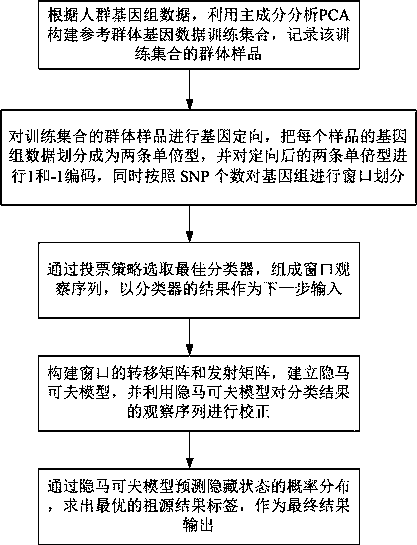Ancestor source polymorphism prediction method based on big data artificial intelligence algorithm
A technology of artificial intelligence and predictive methods, applied in the field of big data research
- Summary
- Abstract
- Description
- Claims
- Application Information
AI Technical Summary
Problems solved by technology
Method used
Image
Examples
Embodiment 1
[0042] like figure 1 As shown, the present invention is based on the ancestral polymorphism prediction method of big data artificial intelligence algorithm, comprises the following steps:
[0043] A: According to the population genome data, construct a reference population genetic data training set, and record the population samples of the training set;
[0044]B: Carry out gene orientation on the population samples of the training set, divide the genomic data of each sample into two haplotypes, and encode the two haplotypes after orientation with 1 and -1, and at the same time, according to the number of SNPs The genome is divided into windows;
[0045] C: Select the best classifier through the voting strategy, form a window observation sequence, and use the result of the classifier as the next input;
[0046] D: Construct the transfer matrix and emission matrix of the window, establish a hidden Markov model, and use the hidden Markov model to correct the observation sequen...
Embodiment 2
[0077] like Figure 1~2 As shown, based on the method in Example 1, the present invention is used to predict ancestral polymorphisms in the public database of thousands of people, and the results are calculated and performance comparisons are made.
[0078] The following provides relevant terminology explanations and descriptions:
[0079] 1000 Genome Project: Thousand Genomes Project
[0080] HGDP: Human Genome Diversity Project
[0081] Haplotype: Genetically, a combination of alleles that share multiple loci on the same chromosome
[0082] SVM: Support Vector Machine, a machine learning method for artificial intelligence
[0083] HMM: Hidden Markov Model
[0084] SNP: Single Nucleotide Polymorphism
[0085] CHB: Northern Han
[0086] CHS: Southern Han
[0087] JPT: Japanese
[0088] S1. According to the 1000 Genomes Project database, obtain the genome data of the public population, and obtain the population polymorphism label corresponding to each sample; select thr...
PUM
 Login to View More
Login to View More Abstract
Description
Claims
Application Information
 Login to View More
Login to View More - R&D
- Intellectual Property
- Life Sciences
- Materials
- Tech Scout
- Unparalleled Data Quality
- Higher Quality Content
- 60% Fewer Hallucinations
Browse by: Latest US Patents, China's latest patents, Technical Efficacy Thesaurus, Application Domain, Technology Topic, Popular Technical Reports.
© 2025 PatSnap. All rights reserved.Legal|Privacy policy|Modern Slavery Act Transparency Statement|Sitemap|About US| Contact US: help@patsnap.com



